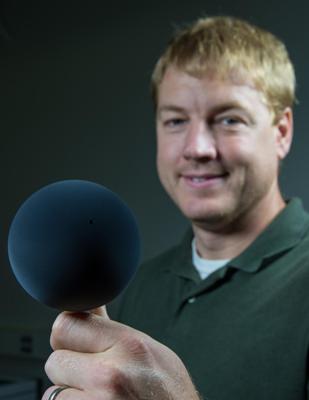NASA Develop Spherical Occulter using Super-Black Carbon-Nanotube Coating to Study the Suns Corona
A team of NASA scientists are working on the development of an occulter, which blocks light from the sun, for use in a CubeSat mission to measure the suns coronal mass ejections. To assist in the production of the occulter the researchers have been using carbon nanotubes to achieve the full absorption of light

Principal Investigator Phillip Chamberlin holds a sphere coated in super-black carbon nanotubes
An occulter is a device that is used to block bright light. This device would fly in formation with a CubeSat, a miniturised satilite, containing an imaging spectrograph to study the suns corona, and more specifically it is coronal mass ejections.
Coronal mass ejections are gigantic bubbles which burst on the suns surface; spewing out a stream of charged particles that move rapidly across the solar system.
These particles have the potential to damage the electronics on Earths power grids or low-Earth-orbiting satellites by slamming into Earths protective magnetosphere.
The novel combination of an occulter working alonside a satellite will allow the speed and temperature of ejected electrons to be measured.
Understanding How the Corona Evolves
Scientists can gain better insights into the evolution of the corona and also the coronal mass ejections (CMEs) with the help of the gathered data.
Currently we can not predict them. We don not know the warning signs. We are like weather forecasters 50 years ago.
Phillip Chamberlin - NASA
The occulter is based on the Spectral Occulter Coronagraph CubeSat or SpOC. SpOC blocks sun light by producing an artificial total solar eclipse. As a result, the corona and the energetic events that occur as a result of it can be revealed. This mission would be carried out by NASA by introducing the CubeSat into an Earth-escape orbit, which travels beyond the orbit of the moon.
The occulter would be dropped by the instrument that carries the mother ship and adjustments would be made to its orbit via thrusters and navigation technology, so that it flies seven feet behind the device.
Snuffing Out the Noise
Coronagraphs are notorious for the high level of noise in their measurements. The light that passes or bends around the edges of an object due to diffraction interferes with the light that needs to be gathered by the instrument.
Chamberlin explained that one way of avoiding light contamination is to position the occulter disk very far from the instrument. The occulter in the SOHO mission it is 2.6 ft away from the coronagraph, and in the STEREO mission it is 4 ft away. For SpOC the occulter plate will be placed at 7 ft, which is almost double the distance for the STEREO mission.
The moon itself acts like a natural coronagraph, revealing a faint halo of coronal light, when it moves into a position between the Earth and the sun once a year at least. The spherical shape of the moon means that the diffraction of it is light is never concentrated; resulting in the faint halo that is observed during an eclipse.
The spherical shape of the titanium sphere used in SpOC enables the suppression of diffraction meaning it is more effective at minimizing noise. Chamberlin intends to further test the effectiveness of applying a coating of carbon-nanotubes onto the sphere.
The coating is extremely black as it is composed of multi-walled nanotubes, made of pure carbon, which are extremely effective at absorbing any stray light. This effectiveness is the result of the absorption of light by the carbon atoms nested in the nanotubes which prevent any reflection.

